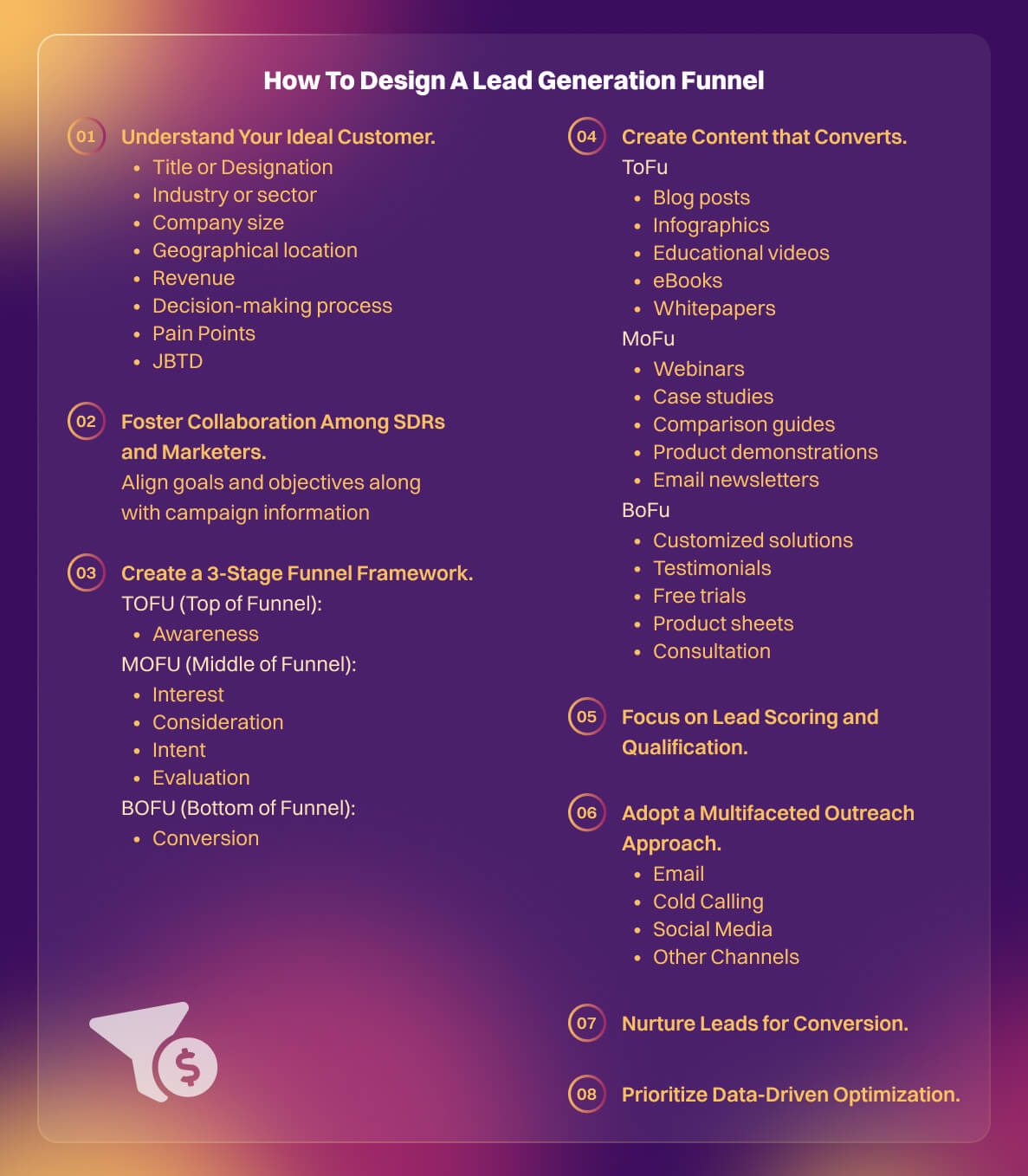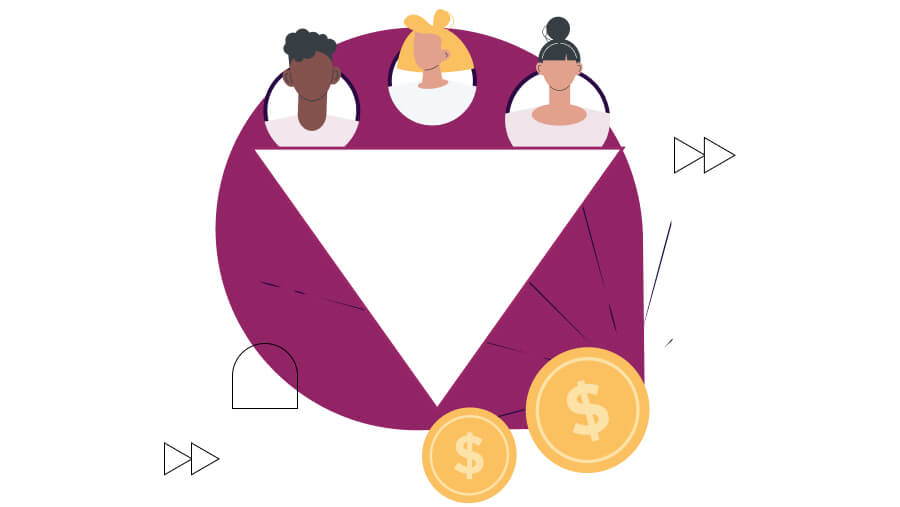
Lead Generation Funnel: 8-Step Framework for B2B Marketers
Ever wondered, as a B2B marketer, what's the biggest challenge in creating a lead generation funnel? It's the art of seamlessly transforming prospects' interests into sales opportunities.
In fact, around 79% of marketing leads never convert into sales. This statistic emphasizes the persistent challenge of effectively nurturing and converting leads within the funnel.
As such, you MUST address the intricate process of designing lead generation conversion funnels that deliver results – sales opportunities. You must also adapt the funnel to fit your company's dynamics. After all, each firm is unique.
Finally, you must set clear goals and conversion benchmarks for each stage to track performance.
Our comprehensive guide is a valuable resource to support you in this venture. You'll discover strategies for constructing and refining your B2B lead generation funnel template.
Additionally, you will discover your customers' entire journey from top to bottom of your lead generation marketing funnel.
How to Optimize a Lead Generation Funnel in 8 Steps
Designing a B2B lead generation funnelinvolves eight essential steps. Let’s check them out:

1. Understand Your Ideal Customer
The initial step is comprehending and defining your Ideal Customer Profile (ICP). Your ICP provides a clear picture of the prospective clients your business seeks to attract and engage. It encompasses various factors such as:
- Title or Designation
- Industry or sector
- Company size
- Geographical location
- Revenue
- Decision-making process
- Pain Points
- JBTD [Jobs to Be Done]
Researching the ICP involves the following elements:
- Analyzing current customer databases
- Investigating market trends and data
- Identifying ideal customer characteristics
- Utilizing third-party data sources
For instance, if you're a software company selling to other businesses, your ICP might consist of mid-sized enterprises (100-500 employees) within the tech industry. These firms may be specifically interested in cloud-based solutions due to security concerns.
The more detailed and accurate your ICP, the better you can tailor your lead gen techniques to resonate with your prospects’ specific requirements.
Let’s say your company's product caters to a niche market within the healthcare industry. In this case, you can consider pain points (regulatory compliance, interoperability issues, and patient data security concerns). Then, create targeted marketing campaigns – emphasizing your product's ability to address the above challenges.
Next, develop your buyer personas – detailed fictional profiles representing your target customers. You can create them based on:
- Surveys and interviews
- Existing customer data
- Online analytics and behavior
- Social media/online community engagement
- Insights from sales and support teams
For instance, here’s an ICP template for a tech startup:
| Name | Sara Mitchell |
| Age: | 28 |
| Location: | New York, NY |
| Position: | Marketing Manager at a tech startup |
| Background: | Sara holds a degree in Marketing and has quickly risen to the position of Marketing Manager within 3 years. |
| Goals: | Elevate the online presence of the tech startup through innovative digital marketing strategies. |
| Challenges: | Limited budget for marketing initiatives and struggles to stay updated on the latest trends in digital marketing. |
| How You Can Help: | Our marketing automation platform is designed for startups with budget constraints. It automates key processes, freeing up time for strategic planning. We also provide regular trend updates to keep Sara ahead in the dynamic digital landscape. |
2. Foster Collaboration Among SDRs and Marketers
Strive to create shared ICPs and buyer personas between your Sales Development Representatives (SDRs) and marketers. This step is one of the crucial lead gen best practices for establishing a unified understanding of the target customer. Here's how it works:
A shared ICP/buyer persona fosters effective collaboration between sales and marketing teams. As such, they can align their efforts and objectives toward common customer goals.
Plus, it allows both teams to understand specific client characteristics, needs, and challenges.
This collaborative approach helps tailor marketing campaigns and sales outreach strategies to resonate with your target audience. It enhances the quality of sales leads generated. Consequently, it increases the likelihood of prospect engagement and conversion. Hence, this maximizes your lead generation funnel's effectiveness.
3. Create a 3-Stage Funnel Framework
What does it mean to design a multi-stage funnel? It involves tailoring your B2B lead generation model to encompass several stages – from the initial touchpoints to the final conversion.
It delineates the sequence of steps a prospect goes through from initial interaction to final conversion. Each funnel stage caters to specific actions and intentions, aligning with the buyer's journey. The key stages usually include:
TOFU (Top of Funnel): Awareness
- Initiating the interaction, this stage provides prospects with an introduction to a company's products or services.
MOFU (Middle of Funnel): Interest, Consideration, Intent, Evaluation
- Interest: Building upon awareness, it focuses on engaging content and information that captures the audience's attention.
- Consideration: Deepening prospects' understanding emphasizes how a product or service solves specific problems.
- Intent and Evaluation: These stages focus on decision-making and convincing prospects of the product's value proposition.
BOFU (Bottom of Funnel): Conversion
- Aiming to close the deal, this stage works to convert prospects into customers.
You must align the funnel stages with your buyer's journey. Shape stage-specific content, strategies, and touchpoints – to match the prospect's evolving needs and their position in the funnel.
This approach will ultimately guide them from initial awareness to the point of conversion.
NOTE: The key here is to provide relevant and tailored information throughout the funnel stages to facilitate the decision-making process of potential customers.
4. Create Content that Converts
When developing content for your B2B lead generation funnel, customize it for the different stages of the customer journey. At the top of the funnel, your primary focus should be on content that raises awareness and captures attention among prospects – such as:
- Blog posts
- Infographics
- Educational videos
- eBooks
- Whitepapers
These resources work well to introduce topics and generate interest.
As prospects move through the funnel, you should focus on more detailed and comparative content – to aid in their evaluation process. Design content like:
- Webinars
- Case studies
- Comparison guides
- Product demonstrations
- Email newsletters
– to provide comprehensive insights and comparisons for informed decision-making.
As potential customers near the bottom of the funnel, your objective is to drive conversion. Here, create resources such as:
- Customized solutions
- Testimonials
- Free trials
- Product sheets
- Consultations
These types of content encourage action, showcasing your brand’s value proposition and addressing final decision-making concerns.
5. Focus on Lead Scoring and Qualification
Lead scoring and qualification are foundational to designing your funnel. These frameworks allow you to prioritize and categorize leads effectively. Here’s how:
What’s Lead Scoring?
Lead scoring involves evaluating and assigning values to leads based on their behavior and interactions with your company. It helps identify the most promising leads for potential conversion. Hence, your sales and marketing teams can focus their efforts efficiently.
Here’s how it works:
This model assigns scores based on lead interactions, such as–
- Website visits
- Content downloads
- Email engagements
- Social media interaction
In addition, it considers demographic factors, like industry, job title, and company size – to define qualified leads better.
What’s Lead Qualification?
Lead qualification, on the other hand, involves assessing leads against a set of defined criteria. It helps determine their readiness to engage with your sales team. Qualification usually occurs after scoring and helps further segment leads based on the following:
- Their alignment with your ICP
- Their engagement with your company
PRO TIP: Your marketers and SDRs should collaborate to establish the criteria for a qualified lead. Shared definitions must align with your company's ICP. It ensures both teams work together to determine when a lead can be passed from marketing to sales.
Remember, clear communication, regular reviews, and an iterative approach are essential in maintaining an effective lead scoring and qualification process.
7. Adopt a Multifaceted Outreach Approach
Utilize multiple communication channels to access diversified touchpoints for engaging with potential leads. It increases the chance of reaching prospects through their preferred communication medium. Here’s a rundown of the effectiveness of various channels:
- Email: An email marketing campaign effectively shares detailed information, industry insights, or relevant content. It allows for personalized and targeted communication.
- Cold Calling: Direct communication through phone calls provides a personalized touch and the opportunity for immediate interaction. It's highly effective in qualifying leads and discussing specific details.
- Social Media: Platforms like LinkedIn, Twitter, and Facebook are valuable for engaging prospects, sharing content, and building relationships. Social media is especially effective in brand building and networking.
- Other Channels: Various other channels like webinars, live chats on the website, and direct mail can complement these primary channels. They offer diversity in communication methods, allowing for comprehensive engagement
7. Nurture Leads for Conversion
Lead nurturing focuses on developing relationships and maintaining engagement with your potential leads. Here are some tried-and-tested strategies:
- Segmented Campaigns: Create targeted content aligned with the different stages of your buyer’s journey. Segmenting leads allows for tailored content delivery based on their interests and engagement level.
- Marketing Automation: Utilize automation tools (HubSpot, MailChimp, Pardot, etc.) to schedule personalized follow-up emails, reminders, and relevant content distribution. They ensure consistency and timely communication.
- Content Sequencing: Develop a series of content pieces that guide prospects through the buying journey. Start with broader educational content and gradually progress to more focused and solution-based material.
- Personalized Communication: Leverage personalization in your communication. Use the lead's name and mention previous interactions or specific pain points discussed. It ensures a more personalized and meaningful conversation.
- Timely Follow-Ups: Maintain a consistent cadence in your follow-ups. Ensure each interaction adds value, whether it's an informative piece of content or addressing a query.
8. Prioritize Data-Driven Optimization
Analytics and key sales metrics for lead gen play a pivotal role in understanding the effectiveness of various strategies. Here's how:
- Informed Decision-making: Data provides insights into prospect behavior, preferences, and conversion patterns. It helps in crafting well-informed choices.
- Bottleneck Identification: Analytics unveil potential issues within your sales funnel. You can identify and rectify issues hindering the conversion process by tracking metrics at each stage by implementing an effective sales funnel optimization strategy.
- Predictive Analysis: Data helps you predict future trends, enabling adjustments and pre-emptive strategies for enhanced outcomes.
That being said, let’s now check out some of the key metrics that highlight the effectiveness of each stage for smooth data-driven marketing:
- Customer Acquisition Cost (CAC): Understand the cost of acquiring customers. It provides insights into your funnel's efficiency and helps in budget allocation.
- Return on Investment (ROI): ROI analysis aids in understanding the effectiveness of each campaign or channel. It contributes to refined strategies and resource allocation.
- Lead Conversion Rate: Lead conversion rate refers to the percentage of leads that transform into customers or take a desired action. Hence, it lets you assess your funnel's overall success and optimization.
PRO TIP: Prioritize iterative optimization – continuous testing, learning, and adjusting based on the obtained data. Based on gathered insights, A/B tests different strategies, layouts, or content – to implement more effective and successful tactics.
This constant cycle of testing and refinement ensures the funnel is continuously optimized and in line with the evolving market and customer needs.
Conclusion
Implementing the strategies discussed in your lead generation efforts can significantly enhance your outcomes. Remember, it's about tailoring your approach to align with your audience and continuously refining strategies based on real-time data and insights.
For further assistance or insights in optimizing your B2B lead generation funnel, contact Revnew. Our experts will offer comprehensive support and expertise to boost your lead generation performance.




